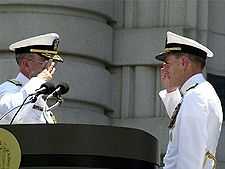Military courtesy
Military courtesy is one of the defining features of a professional military force. These courtesies form a strict and sometimes elaborate code of conduct.

Military courtesy is an extension and a formalization of courtesies practiced in a culture's everyday life. It is intended to reinforce discipline and the chain of command, defining how soldiers will treat their superiors and vice versa. They are also thought to enhance esprit de corps.
Some military courtesies include proper forms of address ("Sir", "Ma'am", "Mister") and when each should be used; the salute, and the related concept of standing at attention; proper wear of military headgear; obeisance; and the rules for behavior in various ceremonies. Specifics can vary depending on an individual's rank, location, and circumstances. A military funeral, for example, requires stricter etiquette than a normal day. Courtesies are sometimes relaxed under battlefield conditions; officers may discourage salutes in combat areas to avoid making themselves a target for snipers, and indeed in the United States of America as well as some Commonwealth nations, it is forbidden to salute both indoors, and when in "the field", a battle situation where snipers are likely to pick out officer targets watching for salutes.
There are military customs that have specific purposes. In the United States Navy, "bracing" is the practice of bracing one's self against the bulkhead (wall) at the position of attention as a superior officer walks by. This practice arose because of the narrow passageways on ships. Since officers may need to quickly move about the ship, sailors would get out of the officer's way by bracing. The tradition has extended to include the corridors and hallways of buildings (depending on the situation) and is mostly an obeisance, however it still serves a useful purpose aboard ships (especially submarines.)
According to Field Manual 7-21.13 4-4 ‘’Courtesy among members of the Armed Forces is vital to maintain military discipline. Military courtesy means good manners and politeness in dealing with other people. Courteous behavior provides a basis for developing good human relations. The distinction between civilian and military courtesy is that military courtesy was developed in a military atmosphere and has become an integral part of serving in uniform. ’’ Military courtesy has been established over the years to establish and maintain order and structure that is the back bone of the Military.
Military courtesies may also be adopted by paramilitary organizations.
See also
- Warrior code
References
- Swartz, Oretha. Service Etiquette, Naval Institute Press, Annapolis, MD.
- (covers customs of the United States Military)